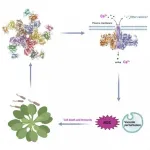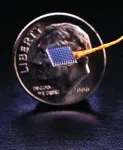Scientists uncover how resistance proteins protect plants from pathogens
2021-05-12
(Press-News.org) In plants, disease resistance proteins serve as major immune receptors that sense pathogens and pests and trigger robust defense responses. Scientists previously found that one such disease resistance protein, ZAR1, is transformed into a highly ordered protein complex called a resistosome upon detection of invading pathogens, providing the first clue as to how plant disease resistance proteins work. Precisely how a resistosome activates plant defenses, however, has been unclear.
A joint team led by Profs. ZHOU Jianmin, CHEN Yuhang and HE Kangmin at the Institute of Genetics and Developmental Biology of the Chinese Academy of Sciences and Prof. CHAI Jijie at Tsinghua University recently employed state-of-the-art electrophysiology and single-molecule imaging to investigate the molecular mechanism by which the ZAR1 resistosome activates plant immunity.
By using Xenopus oocyte- and planar lipid bilayer-based electrophysiology studies, the researchers first showed that the ZAR1 resistosome is a cation-selective, calcium-permeable ion channel. They then applied single-molecule imaging to show that the activated ZAR1 resistosome forms pentameric oligomers in the plasma membrane of the plant cell, confirming previous structural data.
The formation of ZAR1 resistosome in the plant cell triggers sustained calcium ion influx and subsequent immune signaling events leading to cell death, and these processes are all dependent on the activity of the ion channel.
Together, these results support the conclusion that the calcium signal triggered by the ZAR1 channel initiates immune activation, thus providing crucial insights into the working of plant immune systems.
Disease resistance proteins are the largest family of plant immune receptors and are of major agricultural importance in protecting crop plants from assault by diverse pathogens and pests including viruses, bacteria, fungi, oomycetes, nematodes, insects, and parasitic weeds.
The findings of this study shed light on the precise biochemical function of many disease resistance proteins, and suggest new methods for controlling diseases and pest damage in crop plants.
This work "presents important findings that will change our view of ETI-triggered cell death," said a reviewer from Cell. "The use of TIRF to visualize and monitor in real-time membrane-associated resistosomes is very exciting and many researchers will strive to emulate this method."
INFORMATION:
This study, entitled "The ZAR1 resistosome is a calcium-permeable channel triggering plant immune signaling," was published online in Cell on May 12.
The research was supported by the National Natural Science Foundation of China and the National Key Research and Development Program of China.
[Attachments] See images for this press release:

ELSE PRESS RELEASES FROM THIS DATE:
2021-05-12
Scientists are exploring a number of ways for people with disabilities to communicate with their thoughts. The newest and fastest turns back to a vintage means for expressing oneself: handwriting.
For the first time, researchers have deciphered the brain activity associated with trying to write letters by hand. Working with a participant with paralysis who has sensors implanted in his brain, the team used an algorithm to identify letters as he attempted to write them. Then, the system displayed the text on a screen - in real time.
The innovation could, with further development, let people with paralysis rapidly ...
2021-05-12
PROVIDENCE, R.I. [Brown University] -- Researchers with the BrainGate collaboration have, for the first time, used an implanted sensor to record the brain signals associated with handwriting, and used those signals to create text on a computer in real time.
In a study published in the journal Nature, a clinical trial participant with cervical spinal cord injury used the system to "type" words on a computer at a rate of 90 characters per minute, more than double the previous record for typing with a brain-computer interface. This was done by the participant merely thinking about the hand motions involved in creating written letters.
The research team is hopeful that such a system could one day help to restore ...
2021-05-12
Scientists have for the first time revealed the structure surrounding important receptors in the brain's hippocampus, the seat of memory and learning.
The study, carried out at Oregon Health & Science University, published today in the journal Nature.
The new study focuses on the organization and function of glutamate receptors, a type of neurotransmitter receptor involved in sensing signals between nerve cells in the hippocampus region of the brain. The study reveals the molecular structure of three major complexes of glutamate receptors in the hippocampus.
The findings may be immediately useful in drug development for conditions such as epilepsy, said senior author Eric Gouaux, Ph.D., senior scientist in the OHSU Vollum Institute, ...
2021-05-12
Stanford scientists' software turns 'mental handwriting' into on-screen words, sentences
Call it "mindwriting."
The combination of mental effort and state-of-the-art technology have allowed a man with immobilized limbs to communicate by text at speeds rivaling those achieved by his able-bodied peers texting on a smartphone.
Stanford University investigators have coupled artificial-intelligence software with a device, called a brain-computer interface, implanted in the brain of a man with full-body paralysis. The software was able to decode information from the BCI to quickly convert the man's thoughts about handwriting into text on a computer screen.
The man was able to write ...
2021-05-12
What The Study Did: Researchers describe overdose deaths in San Francisco before and after the initial COVID-19 shelter-in-place order to try to make clear whether characteristics of fatal overdoses changed during this time in an effort to guide future prevention efforts.
Authors: Luke N. Rodda, Ph.D., of the Office of the Chief Medical Examiner for the city and county of San Francisco, is the corresponding author.
To access the embargoed study: Visit our For The Media website at this link https://media.jamanetwork.com/
(doi:10.1001/jamanetworkopen.2021.10452)
Editor's Note: The article includes conflict of interest and funding/support disclosures. Please see the article for additional information, including other authors, ...
2021-05-12
What The Study Did: Rates of preterm birth and stillbirth in Ontario, Canada, during the first six months of the COVID-19 pandemic are evaluated in this study.
Authors: Andrea N. Simpson, M.D., M.Sc., of St Michael's Hospital, Unity Health Toronto, in Toronto, is the corresponding author.
To access the embargoed study: Visit our For The Media website at this link https://media.jamanetwork.com/
(doi:10.1001/jamanetworkopen.2021.10104)
Editor's Note: The article includes funding/support disclosures. Please see the article for additional information, including other authors, author contributions and affiliations, conflict of interest and financial disclosures, and funding and support.
INFORMATION:
Media advisory: The full study is linked to this news release.
Embed this ...
2021-05-12
What The Study Did: This survey study estimated the number of children and adolescents in the United States who have received medical care as a result of assault, abuse or exposure to violence.
Authors: David Finkelhor, Ph.D., of the University of New Hampshire in Durham, is the corresponding author.
To access the embargoed study: Visit our For The Media website at this link https://media.jamanetwork.com/
(doi:10.1001/jamanetworkopen.2021.9250)
Editor's Note: The article includes conflict of interest and funding/support disclosures. Please see the article for additional information, including other authors, author contributions and affiliations, conflict of interest and ...
2021-05-12
What The Study Did: Researchers used registry data to examine the number, characteristics and outcomes of patients with sunburns severe enough to warrant admission to specialist burn services in Australia and New Zealand.
Authors: Lincoln M. Tracy, Ph.D., of Monash University in Melbourne, Australia, is the corresponding author.
To access the embargoed study: Visit our For The Media website at this link https://media.jamanetwork.com/
(doi:10.1001/jamadermatol.2021.1110)
Editor's Note: The article includes funding/support disclosures. Please see the article for additional information, including other authors, ...
2021-05-12
What The Study Did: Delayed localized injection-site reactions to the Moderna COVID-19 vaccine for 16 patients are described in this report.
Authors: Alicia J. Little, M.D., Ph.D., of the Yale University School of Medicine in New Haven, Connecticut, is the corresponding author.
To access the embargoed study: Visit our For The Media website at this link https://media.jamanetwork.com/
(doi:10.1001/jamadermatol.2021.1214)
Editor's Note: The article includes conflicts of interest disclosures. Please see the article for additional information, including other authors, author contributions and affiliations, conflict ...
2021-05-12
HOUSTON - The mitochondrial enzyme dihydroorotate dehydrogenase (DHODH) plays an important and previously unknown role in blocking a form of cell death called ferroptosis, according to a new study published today in Nature by researchers at The University of Texas MD Anderson Cancer Center. Preclinical findings suggest that targeting DHODH can restore ferroptosis-driven cell death, pointing to new therapeutic strategies that may be used to induce ferroptosis and inhibit tumor growth.
"By understanding ferroptosis and how cells defend against it, we can develop therapeutic strategies to block those defense mechanisms and trigger cell death," said senior author Boyi Gan, Ph.D., associate professor of Experimental ...
LAST 30 PRESS RELEASES:
[Press-News.org] Scientists uncover how resistance proteins protect plants from pathogens


